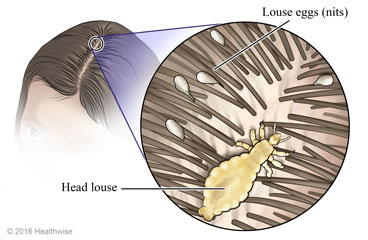Head Lice in Children: Care Instructions

Overview
Head lice are tiny bugs that can live in the hair and on the head. Live lice are tan to greyish white. They're about the size of a sesame seed. It may be easiest to find them on the back of your child's neck at the hairline or behind the ears. When your child has lice, all people living in your home need to be carefully checked and then treated if they have it.
Lice eggs (nits) may be easier to see than live lice. They look like tiny yellow or white dots attached to the hair, close to the scalp. Nits can look like dandruff. But you can't pick them off with your fingernail or brush them away.
Lice aren't dangerous. They don't spread disease or have anything to do with how clean someone is. The lice may make your child's head itch. This is because of your child's body's reaction to the lice bites.
You can treat lice and their eggs with over-the-counter medicines. After treatment, your child's skin may itch for a week or more.
Head lice are most common in preschool and elementary school children. Children who have lice should be able to keep going to school. Experts recommend that children should not be kept from school because of lice or nits.
Follow-up care is a key part of your child's treatment and safety. Be sure to make and go to all appointments, and call your doctor or nurse advice line (811 in most provinces and territories) if your child is having problems. It's also a good idea to know your child's test results and keep a list of the medicines your child takes.
How can you care for your child at home?
- Use an over-the-counter medicine to kill lice. Your doctor or pharmacist can help you choose a medicine that is safe for your child.
- Follow the directions that come with the medicine carefully. Some medicines should only be used once. Others require a second treatment 7 to 9 days after the first treatment.
- Do not shampoo or condition your child's hair before you use the medicine. It's best to wait 1 to 2 days after you use the medicine before washing your child's hair.
- To rinse out the medicine, use warm (not hot) water. Make sure to wash out the medicine over the sink instead of the shower. This helps to avoid some of the medicine coming into contact with your child's skin.
- Check your child's scalp for live, active lice 12 hours after treatment. If you find any, talk to your doctor. Your child may need a different type of treatment.
- Try wet-combing, which may help remove lice and nits. Use a comb with teeth that are close together. A flea comb that's made for dogs and cats will also work. Wet the hair. Comb all of the hair very carefully. Combing needs to be done over and over.
- Try to keep your child from scratching. It may help to trim your child's fingernails. Scratching can cause sores on their scalp, which can lead to an infection. You can try an over-the-counter anti-itch cream to calm the itching. If the itching is really bad, ask the doctor about an over-the-counter antihistamine. Read and follow all instructions on the label.
How can you help prevent them?
- Check everyone in your home for lice. If your child shares a bed with someone, the other person should be treated too. (Don't worry about pets. They can't get lice.)
- Teach your children not to share anything that comes into contact with hair. For example, don't share hair bands, towels, helmets, hats, combs, or brushes.
- You don't need to spend a lot of time or money deep cleaning your home. But it's a good idea to:
- Soak hairbrushes, combs, barrettes, and other items for 10 minutes in hot water.
- Machine-wash clothes, bedding, towels, and hats that touched the head in the last 2 days in hot water. Dry them in a hot dryer. If you don't have access to a washing machine or if items can't be washed or dried, store these items in a sealed plastic bag for 14 days.
- Vacuum carpets, mattresses, couches, and other upholstered furniture.
When should you call for help?
Call your doctor or nurse advice line now or seek immediate medical care if:
- Your child has a sore on their scalp and you think it might be infected. Signs of an infection include:
- Increased pain, warmth, and redness around the sore.
- Red streaks coming from the sore.
- A fever.
Watch closely for changes in your child's health, and be sure to contact your doctor or nurse advice line if:
- You see live lice or new nits after you have followed the directions for your medicine.
Where can you learn more?
Go to https://www.healthwise.net/patientEd
Enter L208 in the search box to learn more about "Head Lice in Children: Care Instructions".
Adaptation Date: 03/15/2024
Adapted By: Alberta Health Services
Adaptation Reviewed By: Alberta Health Services
